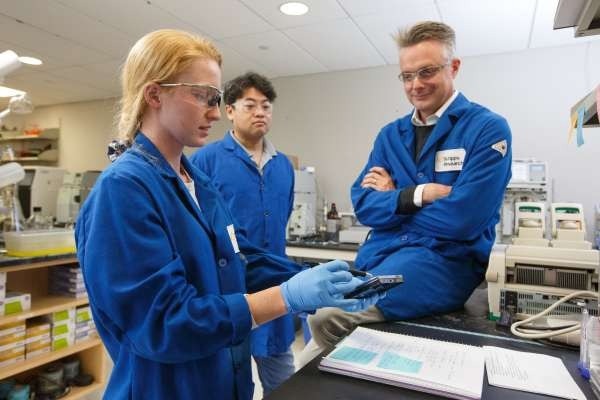Researchers at UF Scripps Biomedical Research have created a potential treatment for a major factor in the development of ALS and dementia that functions by removing disease-causing RNA segments. The compound reestablished the neurons’ health and saved diseased mice.
 Jessica Bush, a graduate student at UF Scripps Biomedical Research, confers with her mentor, chemistry department chair Matthew Disney, in their Jupiter, Florida laboratory. Image Credit: University of Florida Scripps Biomedical Research
Jessica Bush, a graduate student at UF Scripps Biomedical Research, confers with her mentor, chemistry department chair Matthew Disney, in their Jupiter, Florida laboratory. Image Credit: University of Florida Scripps Biomedical Research
The scientific journal Proceedings of the National Academy of Sciences published a summary of the potential drug this week. According to the lead inventor and chair of the chemistry department at UF Scripps, professor Matthew Disney, PhD, it is intended to be administered as a pill or an injection.
Importantly, tests revealed that the substance is sufficiently small to cross the blood-brain barrier, which other methods have been unable to do, according to him.
ALS, also known as amyotrophic lateral sclerosis, gradually kills the neurons that control muscles, causing worsening muscle loss and ultimately death. The mutation is known as “C9 open reading frame 72,” or C9orf72, and is a major contributor to inherited ALS.
Additionally, one type of frontotemporal dementia, which shrinks the frontal and temporal lobes of the brain and alters personality, behavior, and speech before killing the patient, is caused by this mutation.
Chromosome 9 contains an expanded repeat of six “letters” of genetic code, GGGGCC, which may be duplicated anywhere between 65 and tens of thousands of times in the C9orf72 mutation. The presence of this mutated stretch of RNA causes the production of toxic proteins that afflict and ultimately kill affected neurons.
Disney’s research team has created a compound that specifically targets the RNA responsible for carrying those genetic instructions, preventing the cells from assembling the toxic proteins.
The compound works by binding to and using natural cellular processes to eliminate that disease-causing RNA by alerting the cell’s degradation machinery to dispose of it as waste.”
Matthew Disney, PhD, Lead Inventor and Chair of the Chemistry Department, University of Florida Scripps Biomedical Research
He added that this strategy might be effective for other neurological disorders that are incurable and in which toxic RNA plays a role.
Jessica Bush, a graduate student in Disney’s lab at UF Scripps’ Skaggs Graduate School of Chemical and Biological Sciences, is the study’s first author. Leonard Petrucelli, PhD, of the Mayo Clinic in Jacksonville, and Raphael Benhamou, a former postdoctoral researcher at the Disney lab who is currently on the faculty of the Hebrew University of Jerusalem, are additional co-authors.
This was identified from a large screen of compounds from the Calibr library at Scripps Research, which is comprised of 11,000 drug-like molecules.”
Jessica Bush, Study First Author and Graduate Student, Skaggs Graduate School of Chemical and Biological Sciences, University of Florida Scripps Biomedical Research
They discovered 69 compounds from that initial screen that prevented the toxic C9 mutation from being translated. The compounds were then further refined by removing those that, due to their size, weight, structure, or other characteristics, could not pass the blood-brain barrier.
This produced 16 candidate compounds, of which one was chosen for further refinement due to its potency and simple structural design.
Bush added, “A battery of tests in neurons derived from ALS patients and in vivo models showed that compound 1 bound selectively and avidly to the toxic RNA, forcing it to be degraded by the body’s own natural processes.”
The Laboratory for Neurodegenerative Research at Johns Hopkins University School of Medicine received skin samples from ALS patients for research purposes. The Disney team treated these skin cells over a period of months to turn them into neurons after genetically reverting them to stem cells.
“Four different patients’ cells were used for the assessment, all of which showed dose-dependent reduction in known ALS markers while having no off-target effects,” Bush further stated.
Additionally, they examined the drug in mice bred to have the C9orf72 mutation and to exhibit ALS-related behaviors and blood markers. After receiving treatment twice a day for two weeks, the mice showed a marked reduction in disease markers and an improvement in overall health.
The effects of the compound on cellular health and rodent models of C9 ALS will be further investigated in the coming stages, according to Disney. According to the evidence so far, this strategy represents a significant advancement in the study of RNA drugs.
Disney added, “We show for the first time that you can make brain-penetrant molecules that eliminate toxic gene products. The fact that we have highlighted this in ALS shows that this can be a general approach for other neurological diseases, including Huntington’s, forms of muscular dystrophy, and others.”
Source:
Journal reference:
Bush, J. A., et al. (2022). A blood–brain penetrant RNA-targeted small molecule triggers elimination of r(G4C2)exp in c9ALS/FTD via the nuclear RNA exosome. Proceedings of the National Academy of Sciences. doi.org/10.1073/pnas.2210532119